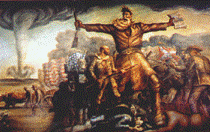History, Department of

James A. Rawley Graduate Conference in the Humanities
Date of this Version
April 2008
Document Type
Article
Abstract
The consolidation of Native American groups onto reservations often resulted in the formation of new communities that developed a collective identity from the shared experience of forced assimilation and occupation. Rarely do historians associate the reservation border towns as extensions of this community. The racial, social, and cultural differences between reservation and white populations are often perceived to be too divergent to have fostered a regional community. Indeed, for most intercultural interactions this assumption holds true. Thus the reservation fairs held in the early twentieth century offer a unique instance in which rural populations on and off the reservation came together as a regional community to celebrate common interest such as equestrian sports, dancing, and agricultural production. This paper will examine the development of the Annual Pine Ridge Reservation Fair and the ways in which it fostered a multicultural community during a time period known for intolerance and racism.
Many studies on multicultural interactions have used Richard White’s concept of the “middle ground” to explain the negotiations and hybrid societies that developed as a result of cooperative interactions. This study also utilizes the concept to illustrate how “playing” at the fairs was itself a “middle ground” because it necessitated agreeing upon rules and maintaining mutual trust. This study treads a new path by expanding the lens of what can be considered a “middle ground,” and also the time periods in which such interactions occurred.


Comments
Paper presented at the 3rd Annual James A. Rawley Conference in the Humanities — Imagining Communities: People, Places, Meanings. Lincoln, Nebraska, April 12, 2008. Sponsored by the University of Nebraska–Lincoln History Graduate Students’ Association. Copyright © 2008 Elisabeth M. Saunders.